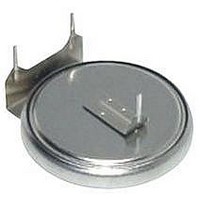BR2335T3L-BA RAYOVAC, BR2335T3L-BA Datasheet - Page 2

BR2335T3L-BA
Manufacturer Part Number
BR2335T3L-BA
Description
LITHIUM BATTERY, 3V, COIN CELL
Manufacturer
RAYOVAC
Datasheet
1.BR1225.pdf
(26 pages)
Specifications of BR2335T3L-BA
Battery Size Code
Coin Cell
Battery Capacity
300mAh
Battery Voltage
3V
Battery Technology
Lithium
Battery Terminals
Solder Tab
External Diameter
23mm
External Height
9.83mm
Available stocks
Company
Part Number
Manufacturer
Quantity
Price
Company:
Part Number:
BR2335T3L-BA
Manufacturer:
MAXIM
Quantity:
1 200
V. Construction
VI. Battery Selection
Component Class Batteries and Cells
Today’s circuit designers recognize the capabilities
of BR Lithium coin cells and FB batteries to function
as permanent components in their circuits.
FB batteries exhibit reliability rates similar to diodes
and resistors.
The combination of very low power Complementary
Metal-Oxide Semiconductor (CMOS) memory
devices with high energy, long life batteries now
allow for batteries to be used as life-of-product
components.
The traditional approach to product design is to
provide sufficient energy to meet a design target
for a stated period, at which time the batteries
would be replaced. The decision to provide
component or expendable power is fundamental to
the product concept of the device being powered.
Component batteries allow the designer to increase
the reliability and functionality of the device by
eliminating the need for consumer replacement
of batteries. Component batteries eliminate the
problems of reversed polarity, wrong chemical
system, mismatched capacities, and higher
operating costs. However, component batteries
require careful selection. The batteries must assure
adequate energy for the expected load to compen-
sate for self-discharge and the thermal environment
expected, and the batteries must also have a high
reliability connection to the circuit.
Gasket
CF x Cathode
Current Collector
(–)
(+)
Separator and Electrolyte
Lithium Anode
Anode Cap
Cell Can
2
Today’s demand for high performance, small
footprint, reliable, and cost-effective electronic
products can be realized by identifying the best
match between the battery and its application.
To do so requires a good understanding of the
device’s power requirements and the environment
in which it is used as well as how the battery reacts
to those loads and environments.
It is important that the battery be considered early
in the design process. This will allow the optimiza-
tion of battery life through the selection of power
conserving circuit components. Moreover, early
battery selection will also minimize circuit and
mechanical layout changes later in the design process.
The following is a list of basic application
characteristics and conditions that must be
considered for an optimum selection of a lithium
Carbon-monofluoride power source.
Electrical Characteristics
•
•
•
•
Application Goals
•
•
•
•
•
•
Packaging
•
•
•
•
•
Environmental
•
•
•
•
•
Voltage: maximum/minimum
Current drain
Pulse currents
Pulse time/frequency of occurrence
Duty cycle
Service life goal
Shelf life goal
Reliability
Safety
Battery availability
Shape
Terminals
Weight
Contact materials
Case materials
Operating temperature range
Storage temperature range
Humidity
Shock and vibration
Atmospheric pressure
















